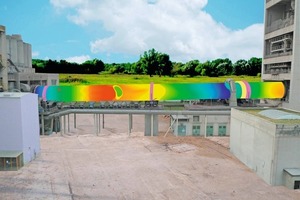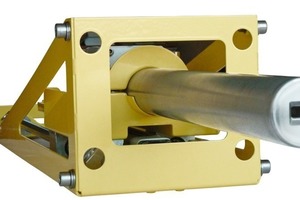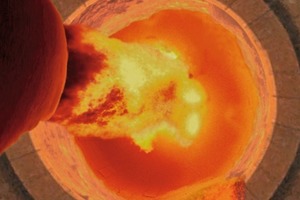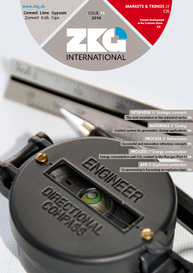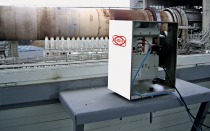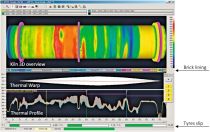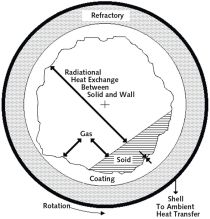Infrared line scanner for rotary kiln shell temperature monitoring
1 Introduction
Kiln performance and reliability is essential to profitable plant operations. A rotary kiln shell has to withstand harsh conditions. The steel and refractory lining structure is heated by a flame at 2000 °C while the outside surface temperature is around 450 °C, using significant temperature gradients. The refractory lining prevents the shell from excessive heating, but as brick failure eventually occurs, thermal shocks become a serious concern. Any fall of a refractory brick may stop operations for few weeks and the associated loss in production could amount to more than a million dollars.
The privately owned Tianrui Group Cement Co., headquartered in Hong Kong, China is one of the twelve largest cement groups in its home country. The Xingyang plant, located in the Henan province at Ruzhou City, was commissioned in 2009 and is one of the world´s largest single-kiln production lines. The plant uses a suspension preheater kiln layout with a 6.2 m x 92 m long rotary kiln. The grate cooler has 13 cooling fans with a downstream waste heat utilization including a power station.
Tianrui wanted to monitor this 92 m-rotary kiln to prevent any interruption in production due to hot spots and to control the burning process. Reliability, performance of equipment and industry experience were all considered in this highly visible project. Two HGH Infrared Systems’ Kilnscans with merged imaging were selected to maximize kiln coverage and eliminate shadows. The kiln scanner had to have the capability to provide a hot spot size detection size small enough not to miss a single brick fall. At greater distances, this aspect would become a challenge as the required sensor spatial resolution would have to be excellent.
2 Challenge
The Xingyang rotary kiln shell is a massive, heavy hollow steel cylinder weighing thousands of tons and only supported by a few rollers, representing a few discrete point loads. With time, the shell would naturally deform under its own weight and flex along its longitudinal axis, exhibiting an oval cross-section. These distortions would increase constraints on refractory bricks and impact operating life.
From a design point of view, the Xingyang kiln had tertiary air ducts running along its sides and the supporting legs were in the field of view of the scanner system. This layout would generate shadows when installing a line scanner. The plant had to find a solution to insure that no obstruction would impair the monitoring process.
Mechanical tensions could also be induced by the inclination given to the kiln. When operating, the kiln shell would rotate with a speed up to 5 rpm and an angle of a few degrees, in order to move material slowly down from the preheater tower close to the flame for clinkerization. As the shell would only be lying on support rollers, the alignment would have to be adjusted slightly between the roller shafts and tyre axes to preserve the balance in the kiln axial thrust. In the long term, this small difference in the slopes between rollers and tyres would have serious impact on the shell stability. A subsequent axial drift could damage stop blocks, generate overheating of bearings, jeopardize the kiln drive system or even cause cracks to the kiln. Thus, rotary kiln tyre slip monitoring was required.
Energy savings and improvements in the burning process were also considered when making a choice for a kiln monitoring system. If chosen carefully, the thermal scanner should not only provide notice in case of emergency but also extend the kiln lifetime and allow for increased production output.
Last but not least, the Chinese plant, as with all cement plants, operates in a harsh environment and required ruggedized equipment.
3 Solution
The solution for HGH was to install two 90 degree field-of-view kilnscans. This enabled 100 % elimination of the shadows caused by the existing structures to completely view the entire kiln scanning system. HGH staff performed an exact positioning; using an oscilloscope, to make sure the kiln scanner’s field of view would encompass the whole kiln axis. One scanner was installed at the top of a 15 m high tower and the other on the roof of an adjacent building, covered by a canopy.
The signal from each scanner was taken into a common signal processing unit via fibre optic cables. The processing unit was installed in the electronic component room, adjacent to the control room and connected via Ethernet cable to the PC and displayed where the SIRCIM software was running. The commissioning and training took place in three days.
The HGH Kilnscan is a high end system providing single brick resolution, which allows for quick problem detection and proactive actions to re-build coating: The maintenance manager gets the necessary information to locally cool down the shell with fans or modify the burner settings if needed. The quality of the Kilnscan’s optics guarantees that the beam angle out of the scanner is adequate to provide early warning in case of problems.
Average or low quality optics would negatively impact the warning cycle: Scanners with low resolution can give a late warning by averaging the temperature peaks on the thermal map. When it comes to hot spot detection, a late warning may result in high costs for repairs, standstill etc..
Additionally to high spatial resolution, the Kilnscan has excellent thermal sensitivity: At less than 1/10 of a degree Celsius, it guarantees sharp and precise display of unwanted change in temperature.
The Kilnscan provides via a user friendly 3-D shell display precise alarms on critical parameters such as hot spots detection, tyre slip or coating loss. High accuracy of measurement needs to be consistent over time though: by using a blackbody as an external temperature reference, or a pyrometer in contact with the shell to measure and correct a potential change of atmospheric conditions, the Kilnscan can recalibrate itself, through the external blackbody, if necessary even without the operator’s intervention.
Historical data management of all relevant parameters, such as temperature profile, brick and coating thickness, kiln speed and tyre slip allows the maintenance manager to get a clear overview of the kiln status and trends in a centralized dashboard. As a result, it is easy to plan for kiln re-alignment or replacement brick purchases. The software communicates with the plant’s Distributed Control System through OPC: All critical information such as kiln speed, individual alarm status, reference blackbody or pyrometer status, kiln shell heat loss can be transmitted and displayed in real time to a central console.
Lastly, the HGH Kilnscan provides another feature. The Thermal Warp Computation allows users to calculate the kiln distortion induced by temperature changes over the shell, letting operators see what’s happening within the kiln: Evolution of coatings, kiln push of unburnt material, potential stress on the shell, tyres or roller stations. By collecting and analyzing this data, the plant manager can get indicators on:
Mechanical and thermal stresses in the shell and tyres
Hot spots under tyres
Load fluctuation supported by each pier
Shell and tyre out-of-round distortion
Breakage of tyres according to the fatigue criteria
Shrinkage stress fluctuations in the rollers
Bending stresses in the roller shafts
Specific pressure fluctuation on the roller bearing
With this data the operator can decrease the shell distortion by adjusting the flame and rotation speed to adapt burning conditions and homogenize the coating. Efficient shell distortion monitoring also results in avoiding hot spots.
4 Results
The plant has been dependably and efficiently operating since its opening. No breakdown or failure caused any production interruption and the two kilnscans are functioning smoothly and reliably. The plant employees and management report that the kiln monitoring system is easy to use and that the images are very clear and precise.
//www.hgh-infrared.com" target="_blank" >www.hgh-infrared.com:www.hgh-infrared.com

